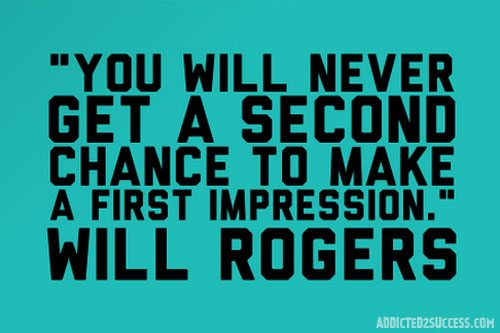Success Advice
4 Ways to Make A Great First Impression On Anyone
You only get one chance to make a great first impression.
No one will remember you, or pay you much attention if your first impression is so unmemorable. But there are many different ways to make sure you make a powerful, memorable first impression, and we’re going to look at four of the most effective methods.
Making A Great Impression
1. Design your elevator pitch
An elevator pitch is how you describe what you do for a living in a short amount of time, usually about thirty seconds. It’s called an elevator pitch because 30 seconds is the amount of time you will normally have to wait for an elevator. During that time it’s important that you can sum up what you do and how you do it. This is also useful in social situations when meeting people for the first time.
If you network with other business people, then along with your business card this is the most important way of getting your message across.
When starting a new business your main marketing tool is….YOU! By meeting people and speaking to them you are going to spread awareness of your business. When I first started working for myself, I had never heard of an elevator pitch or a 30 second story.
If someone asked me what I did I would undermine the importance of my business and be quite vague. This was because I was afraid of what other people would think and also because I hadn’t developed enough confidence in myself.
You don’t have to be starting or own your own business to benefit from having an elevator pitch. Write a thirty second script that you would say to someone when you meet them for the first time. Learning this off by heart can help you make a really good first impression. It’s very important that you deliver it with confidence as you won’t be saying it again to that particular person.
Since I developed my elevator pitch I have stopped sabotaging myself through introductions where I appeared nervous and lacking self-belief. Knowing my elevator speech well allows me to introduce myself with confidence and clarity and describe concisely what I do. You have to look as if you believe in yourself, and sound as if you believe in yourself, to enable others to believe in you too! You need to make it easy for them to connect with you.
2. Speak for Yourself
Sometimes you will be introduced to someone and the person who is making the introduction will do all the talking. If you are anxious or nervous then it is much easier to just stand there, smile and say Hi. In my own experience, I found that people don’t remember you if you don’t say anything and let the other person do all the talking. Speak for yourself.
After you have been introduced, make an effort to engage with that person with a question, for example, ‘do you come to these functions regularly?’ or give them some information about yourself. Try to ask open questions, beginning with ‘how do you….’ or ‘what do you feel about….’ When you really can’t think of anything to say, find something in common, or if you know a little about them, then use it to your advantage, for example ’Jim tells me you were born in Hawaii, what was growing up there like?’
Remember, most people love to talk about themselves!
3. Treat Everyone Like The Gatekeeper To Your Destiny
Joel Osteen, the American preacher and speaker, says that you should treat everyone like the gatekeeper to your destiny. What he means by this is that everyone you meet has the potential to change your life immeasurably and help you get to where you want to be. This is why it is vitally important to treat everyone the same and introduce yourself to as many people as possible, as you never know who will change your life for the better.
I recently met an old family friend whom I had not seen in many years. He did not recognise me and in the past I would have let my anxiety get the better of me and not said hello. These days, I am a lot more confident than I used to be, so I introduced myself and then used my elevator pitch to tell him what I am doing now.
I would have been happy with just the process of introducing myself and using my elevator pitch but the outcome of that chance meeting has been amazing and has provided me with huge opportunities. That is what I’ve found from introducing yourself well and using your elevator pitch. People will think of ways in which they can help you.
Try it out for yourself, and you will see more and more people will want to help you. Enthusiasm is infectious and people want to be a part of your success. You will also realise that there may be ways in which you can help other people and you might even be the gatekeeper to their destiny!
4. Body Language and Attitude
These are common sense tips that you probably already know but are easy to forget about and not to put into practice. Body posture is very important when you meet someone. The human brain will pick up many signals subconsciously from a meeting in a split second to help it form an opinion of you. You want to make sure you are giving off as many positive signals as possible.
Standing up straight is the most basic but the most important. When you stand up straight with your shoulders back you are giving the signal that you are confident in yourself. You also need to speak clearly and purposefully.
Your introduction and elevator pitch will have no impact if you mumble and look at the person’s shoes or over their shoulder. Always look people in the eyes. If you find this difficult then look at people’s eyebrows as they will think you are looking into their eyes. Make sure you smile throughout your meeting. Happiness and enthusiasm are infectious and attractive.
If you are anxious or nervous then meeting people may be difficult for you. It will help you immensely to control your breathing. Take slow deep breaths, this will help you to remain calm and be confident. Say to yourself “I’m calm and relaxed; I want to share who I am and what I do with others”.
If you believe in yourself and seem confident, enthusiastic and genuinely interested in the other person, then you will make a great first impression. Some people may not like you for reasons that are beyond your control, perhaps you remind them of someone or they are just simply having a bad day. If you have negative responses, don’t let this affect you. You are only in control of your own actions and thoughts. The outcomes of your meetings are out of your control so focus on the process!
The majority of the first meetings will be great and you will begin to attract new people into your life who want to help you and be friends with you.
If you have business cards then it’s best to carry them around with you everywhere you go as you never know who you could meet. Having a case is important to keep them in good condition. I’m not suggesting you give them out like confetti to everyone, but it’s important to have some to hand to give to the people who are interested or you think could make a difference to your business.
If you find introducing yourself difficult or you want to improve your first impression then a great way to do it is to practice. Go to a place where you can introduce yourself to someone. A networking event is a great place to meet lots of new people.
If you haven’t got an event coming up soon, practice by introducing yourself to the person serving you in the supermarket, in the bookstore, your neighbour, etc. You will learn something from every interaction especially the ones that are less than perfect.
I hope these tips will enable you to be your authentic, positive, confident self when meeting people and make memorable impressions at every opportunity.

Change Your Mindset
The Silent Skill That Makes People Respect You Instantly
What truly earns respect and why most people go about it the wrong way

Everybody craves respect but not everyone earns it. Some people believe that a title, years of experience, or a position of authority automatically entitles them to respect. (more…)
Entrepreneurs
The Essential Skills Every Entrepreneur Needs In 2026
Success in the digital age isn’t about luck. It’s about mastering the skills that separate dreamers from doers.

When I was 22 years old, I started my first side hustle as a ghostwriter. (more…)
Did You Know
The Success Patterns You Inherited (And Didn’t Notice)
Your family history may hold the key to why you think, act, and feel the way you do today.

Who are you? Your experiences and your family’s narratives and legacies contribute to your identity. Your ancestry contains individual traits and forces that have been inherited over the years. It also carries the fights and victories of your forebears and older family members. (more…)
Shift Your Mindset
11 E’s That Define Every Great Leader And Why Most People Miss Them
If you’ve ever felt the pull to lead, this is your roadmap to turning inner potential into lasting influence.

What Is Leadership, Really?
Leadership is far more than a title or position. It’s the ability to envision a future, inspire others, and align people toward a shared goal. (more…)
-

 Success Advice4 weeks ago
Success Advice4 weeks agoInside the TikTok Resume Hack That’s Fooling Recruiters (For Now)
-

 Change Your Mindset4 weeks ago
Change Your Mindset4 weeks agoThe One Leadership Habit That Separates the Great From the Forgettable
-

 Personal Development3 weeks ago
Personal Development3 weeks agoThis Silent Habit Might Be Sabotaging Your Career
-

 Business3 weeks ago
Business3 weeks agoWhy Your E-Commerce Fulfilment Is Probably Broken (And How to Fix It)
-

 Shift Your Mindset2 weeks ago
Shift Your Mindset2 weeks ago11 E’s That Define Every Great Leader And Why Most People Miss Them
-

 Did You Know2 weeks ago
Did You Know2 weeks agoThe Success Patterns You Inherited (And Didn’t Notice)
-

 Business2 weeks ago
Business2 weeks agoThe Hidden Money Pit in Your Operations (and How to Use It)
-

 Entrepreneurs1 week ago
Entrepreneurs1 week agoThe Essential Skills Every Entrepreneur Needs In 2026



























18 Comments